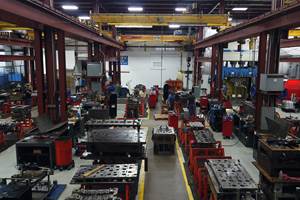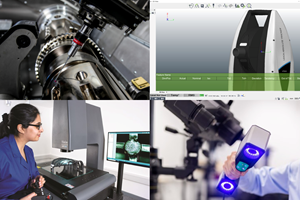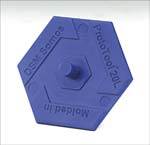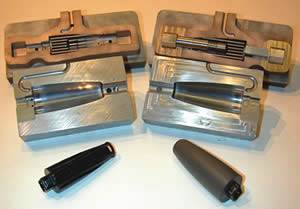Rapid Prototyping/Rapid Tooling: State of the Industry
A look at the market for additive fabrication (also known as rapid prototyping) as it continues to grow.
After more than 15 years of research, development and use, the industry continues to grow with the addition of new technologies, methods and applications of additive fabrication. In an effort to reduce time-to-market, improve quality and reduce cost, companies of all sizes have come to rely on additive processes as tools for conceptual design, prototyping, patterns for molds and castings, custom manufacturing and short-run series production.
The last three years have been tremendous for the industry. The explosive growth that started in late 2003 is still being felt. The engines of growth have cooled some, but they are still warm—and even hot—in some segments of the industry.
The revenues created by the systems, materials, aftermarket products and services are considerable, but not large when compared to many other industries, or even single companies. Another way to view the industry is to consider the overall economic impact it is having on countless design and manufacturing organizations worldwide.
One such organization is a U.S. manufacturer of toys that asked not to be named. The company produces about 1,500 new products each year. Ten years ago, it employed 200 modelmakers and machinists, but today it employs only six. Yet this manufacturer’s modeling and prototyping group processes four to five projects per day and offers 24-hour and same-day delivery. This group produces a staggering 12,000 models per year, and just two people and several additive machines complete 90 percent of the work.
With examples such as this, it is clear that the impact of additive fabrication is big, even at a single company. If we were to expand this impact to include the thousands of other companies that also benefit from the technology, the cost savings would be in the billions of dollars.
The growth of 3-D printers over the past few years has been driving the expansion of the entire industry. 3-D printers continue to lag higher-end systems in typical measures of quality—including accuracy, surface finish and material properties. However, the gap is narrowing. Much of the R&D money in additive fabrication is being spent in this sector of the market. Consequently, the accuracy and surface finish of parts from 3-D printers have improved significantly. The materials available also have improved. Given the growing sales and R&D spending on these systems, anticipate further improvements of these machines and the parts they produce.
Wohlers Report 2006—an in-depth global study on the rapid prototyping and manufacturing state of the industry from Wohlers Associates—indicates that revenue generated from the sale of 3-D printers grew by 35 percent to $100 million in 2005, versus $74 million in 2004—making 3-D printers the fastest growing segment of the industry. The report estimated that 15,000 3-D printers could be sold annually by the year 2010, compared to 2,528 3D printers sold in 2005.
The term rapid manufacturing is gaining acceptance. It is generally used to refer to the use of additive processes to manufacture series production parts rather than models or prototypes. Producing parts without tooling provides a significant advantage, both in cost and time. Conventional processes require tooling that can cost tens of thousands of dollars and typically take several weeks or months to complete.
Increasingly, companies from the aerospace, motor sports, medical, dental and consumer product industries are using additive processes to manufacture high-value parts in comparatively low volumes. Wohlers Associates believes that rapid manufacturing will eventually grow to become the largest application of additive fabrication.
Companies are discovering ways to apply additive processes to the manufacture of finished goods in quantities of one to several thousand. This approach is allowing organizations to design and manufacture new products, including one-off custom products that before were not feasible due to leadtime, cost and risk.
Acknowledgement
The author thanks Tom Mueller of Express Pattern for his assistance with this article.
Related Content
2024 Moldmaking Insights: A Year in Review Part 1
A look back at the top moldmaking trends of 2024, as revealed through MMT's analytics. This review highlights the most popular technical articles, case studies, tips and best practices that captured the industry's attention over the past year.
Read MoreIndiana Mold Builder Decatur Mold Offers a History of Grit and a Future of Innovation
Decatur Mold Tool and Engineering Inc. serves as a tooling tour guide, helping busy tooling managers reduce uncertainty, lighten workload.
Read MorePrecision Meets Innovation at IMTS 2024
After attending IMTS, it's clear that the integration of advanced technologies is ready to enhance precision, efficiency and automation in mold manufacturing processes. It’s a massive event, so here’s a glimpse of what the MMT team experienced firsthand.
Read MoreQuality Control Technologies Geared for Injection Molds
These latest technology solutions, from noncontact gages to test probes and automated inspection systems, aim to minimize production risks and ensure optimal quality control practices for moldmaking.
Read MoreRead Next
Rapid Tooling Via Stereolithography Gets a Closer Look
Industry roundtable reports initial findings.
Read MoreDirect Metal Laser Sintering and Tooling
The applications, benefits and limitations of direct metal laser sintering for mold manufacture.
Read MoreReasons to Use Fiber Lasers for Mold Cleaning
Fiber lasers offer a simplicity, speed, control and portability, minimizing mold cleaning risks.
Read More




















